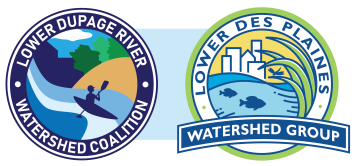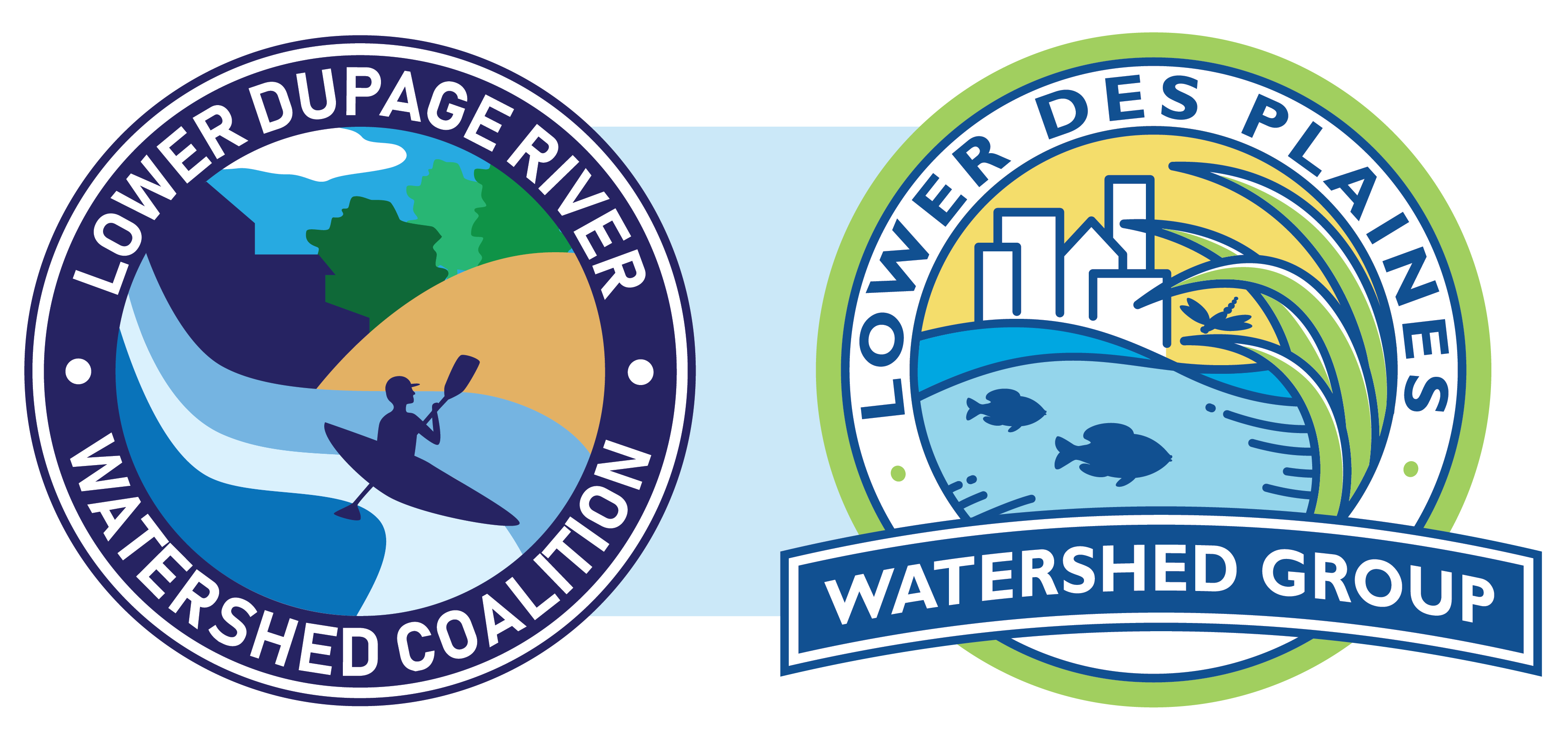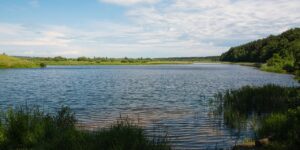Our watersheds are made up of the Lower DuPage River, the Lower Des Plaines River, their tributaries, and the land that surrounds them. This means our homes, schools, workplaces, and natural areas are all a part of the watershed. Whatever we do on the land, impacts the health of our local rivers and streams. Whether that impact is good or bad is up to us.
Here are 10 ways we can protect our watershed and the water quality of the rivers within it:
1. Reduce runoff and conserve water with a rain barrel
A great way to get started with creating an eco-friendly home is to install a rain barrel. Rain barrels are large containers that attach to your downspout and collect water that would otherwise drain into your yard. As a result, rain barrels can sometimes help homeowners with flooding problems on their property.
Rain barrels help our watershed by reducing stormwater runoff. Collecting rain prevents stormwater from flowing across lawns and roads, picking up pollutants along the way. Eventually, stormwater runoff enters rivers and streams through storm drains or detention basins.
Rain barrels also help conserve water, which is especially important for communities that rely on groundwater. Many people use water collected in a rain barrel to water their lawns, gardens, and house plants.
2. Add native plants or a rain garden to your yard
Native plants are watershed protectors too. Illinois prairie plants have deep roots which benefit our watershed in a couple ways. For one, the deep roots keep soil in place and prevent soil erosion. Second, deep roots send water down into the ground. By infiltrating water into the ground, native plants reduce runoff and recharge groundwater resources.
You can incorporate native plants into your landscaping or create a designated rain garden. Create a rain garden by making a depression in your yard and then planting it with water-tolerant native plants. Rain will collect in the rain garden when it rains and then slowly soak into the soil.
Another option is to advocate for native plants in your neighborhood, especially for planting them as a border or buffer around stormwater detention ponds. The natural buffer helps filter out the pollutants in stormwater runoff. They also act as a barrier to Canada geese.
3. Use Leaves as a Resource
There can’t be anything possibly bad about leaves because they’re natural, right? When leaves decompose back into the soil where they fall, they help to restock the soil with nutrients. However, when those leaves get into streets and storm drains, their nutrients are funneled from a broad area into one nearby stream. This spikes the waterway with an unnaturally high amount of nutrients. The phosphorus in leaves feeds algae and can cause an algal bloom that sucks oxygen out of the water. Without oxygen, fish and other aquatic organisms can’t survive.
To prevent algal blooms, we can reduce the amount of nutrients that enter bodies of water. When managing our nutrient-rich fallen leaves, we have a few options:
- Use a mulching mower to shred leaves in place. Mulched leaves decompose much faster than whole leaves and help restore nutrients to the soil where they belong.
- Shred leaves and use them as mulch around trees or in your garden.
- Add leaves to your compost bin, or create a dedicated leaf-mold bin to create a natural garden amendment that boosts the water retention of soil.
- Finally, if the above methods aren’t an option for you, you can participate in your community’s leaf collection program. Most communities require you to bag leaves and bring them to the curb. In some places, residents rake leaves to the curb—but not into the street—and Public Works crew collect them with a large vacuum.
We encourage using leaves as a resource, but the priority is to get leaves off streets and other hard surfaces so that their nutrients are not washed into storm drains that connect directly to rivers and streams.
4. Reduce or Eliminate Lawn Chemicals
When it rains, excess fertilizer on your lawn and sidewalk is picked up by stormwater and carried down storm drains that lead directly to local rivers and streams. The same fertilizers that make grass grow also make algae grow.
Take care of your yard naturally instead of using fertilizers and herbicides on your lawn. You can improve the health of your grass and soil over time instead of using large amounts of fertilizer as a quick fix.
If you do decide to use fertilizers, always follow the product instructions and sweep excess fertilizer off hard surfaces. If fertilizer is left on driveways and sidewalks, it is easily picked up by stormwater and brought into storm drains and detention basins.
5. Pick up Dog Poop, Every Time Everywhere
All the waste created by the dogs in out watershed really adds up! Dog poop contains nutrients and bacteria, both of which degrade water quality. When pet waste is left on the ground, stormwater runoff washes it into nearby waterways. Be a responsible pet owner and steward of our water resources by picking up the poop every time, everywhere.
6. Be Salt Smart - Use the Right Amount of Salt, Not More than Necessary
Our freshwater rivers and streams are getting saltier and saltier. The increase in chloride levels in local waterways parallels the increase of salt applied to roads and parking lots in the winter. Chlorides cause damage to vehicles, infrastructure, vegetation, and especially the health of our rivers and streams. Once salt gets into the water, it is difficult and expensive to remove.
The best way to protect rivers and streams from chlorides is to reduce the amount we use. This does not come at the cost of safety. Road salt is often overapplied and the excess gets washed into storm drains. Instead, we can use the right amount of salt to effectively melt snow and ice without going overboard. That way we can protect pedestrians, motorists, and waterways at the same time.
Learn more about the Salt Smart Collaborative, a collective of northeastern Illinois communities working to reduce chlorides in rivers and streams, at saltsmart.org
7. Keep Storm Drains Clear
Storm drains help manage stormwater and are a direct connection to rivers and streams. Without storm drains, we would see a lot more flooding in our neighborhoods. Therefore, storm drain grates need to be clear so stormwater can pass through. Water can back up into the street when storm drains are blocked by trash and debris.
Municipal street sweeping can help clear storm drains from trash and debris. You can also help by “adopting” the nearest storm drain on your street. The best thing you can do is to make sure the grate is clear before a forecasted storm.
8. Avoid Coal Tar Sealant
When resealing or redoing your driveway, opt for an alternative to coal tar-based sealants. Coal tar-based sealants contain a toxic compound, polycyclic aromatic hydrocarbon (PAH), that is harmful to aquatic life and human health. Like many of the pollutants mentioned previously, PAHs enter rivers and streams via stormwater runoff. Stormwater picks up PAHs as it flows over driveways coated with coal tar-based sealant.
Fortunately, there are alternatives to coal tar-based sealants. Asphalt-based sealcoat products have much lower concentrations of PAHs. If you hire someone to seal your driveway, ask them what type of product they use. You could also choose concrete or brick driveways that do not need sealants.
9. Fix Vehicle Leaks ASAP
If you notice your car leaking engine oil, anti-freeze, brake fluid, or power steering fluid, fix the leak as soon as possible. When these fluids leak onto roads, parking lots, and driveways, they are washed into storm drains when it rains. If you catch your car leaking, use an oil-dry or kitty litter product to absorb the leaked fluids and dispose of it properly.
10. Support Stream Restoration Projects
There is a lot we can do at home to protect nearby rivers and streams from pollution. However, local waterways are also stressed by physical modifications like channelization (straightening a stream), dams, and eroded shorelines. Stream restoration projects return impaired waterways to a more natural state, which helps rivers better handle stormwater, provides habitat for aquatic animals, and ultimately improves water quality.
Residents sometimes have the opportunity to weigh in on or vote for restoration projects. Your support lets municipal leaders and forest preserve commissioners know that their community cares about clean water and healthy rivers.
Thanks for helping your watershed!




